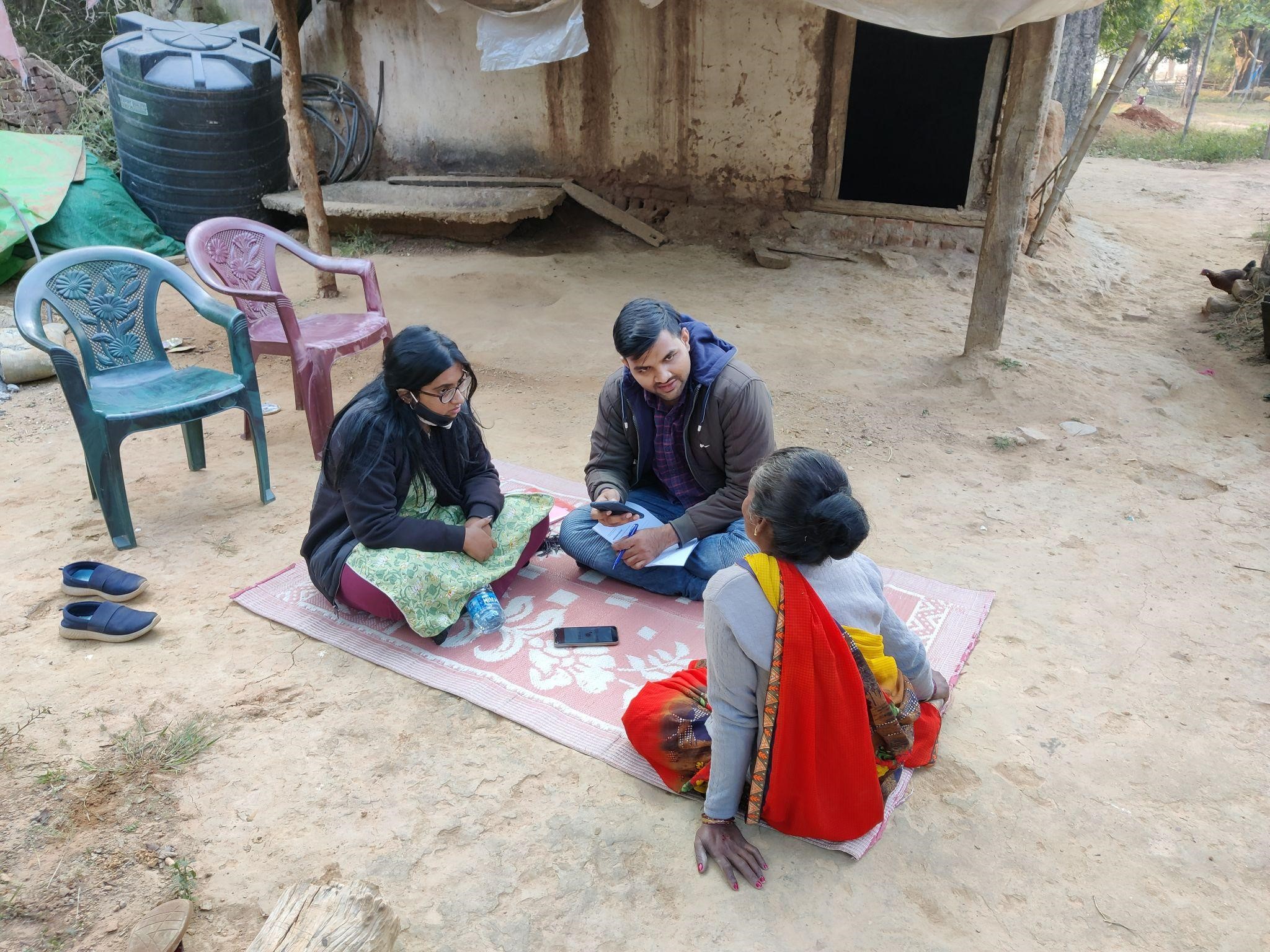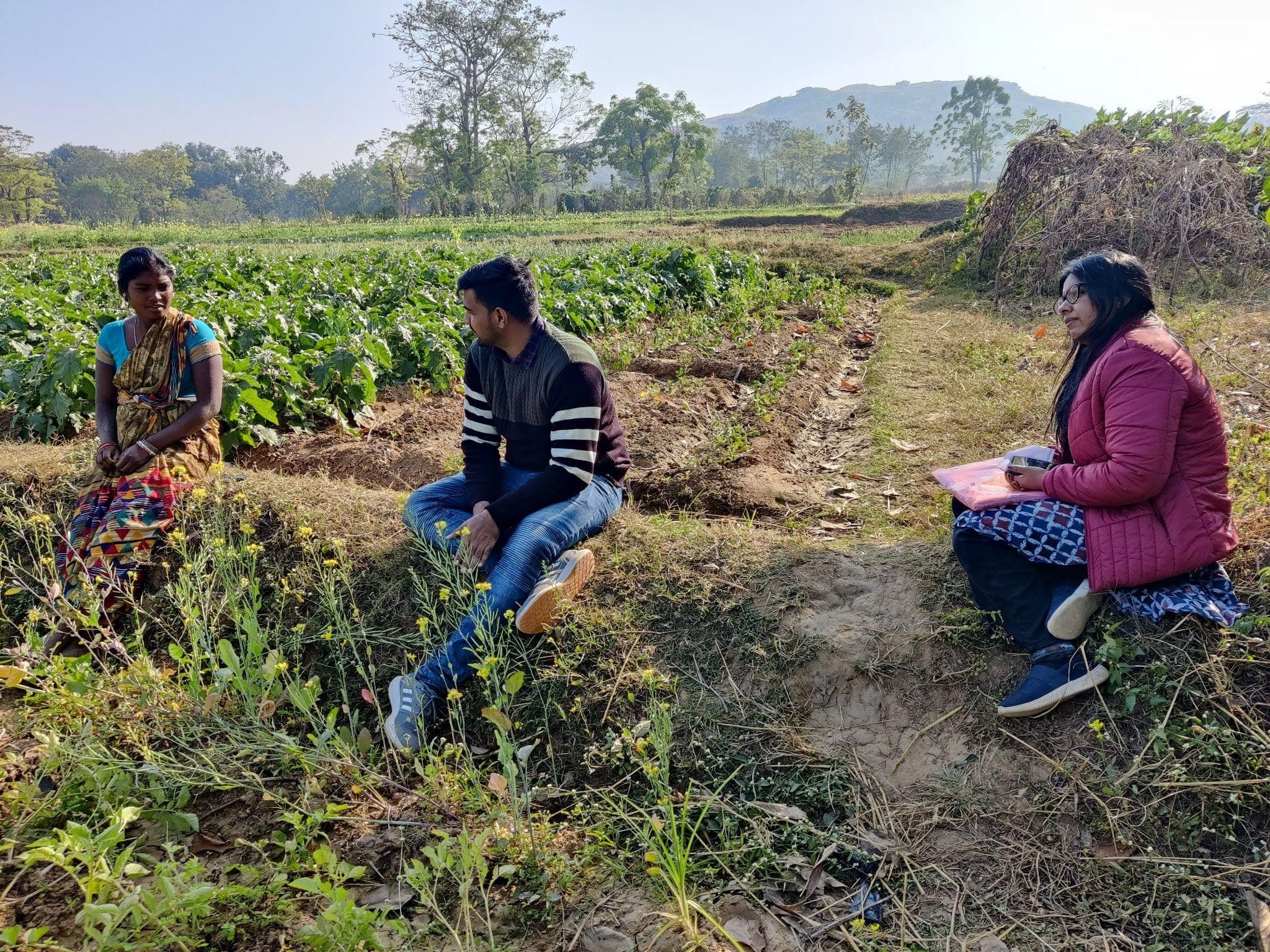



On a sunny winter afternoon, Bahuri Devi gingerly makes her way to her vegetable farm. The sound of dried leaves crushing under her feet fills the air while she tends to newly planted buds of garlic, brinjal, among other vegetables. Devi then switches on the micro solar pump to irrigate the crops.
"Ye bahut acha hai, isko lagana aur lejana asaan hai. Bijli ya tel ke baare mei sochna nehi padhta (This is very good, it is easy to use and carry. I don't have to worry about electricity or diesel)," she tells us.
Devi, 36, is a smallholder tribal farmer from Gumla, Jharkhand, who owns 0.63-acre of farmland. Earlier, she practised farming only for self-sustenance but when a neurological illness rendered her husband immobile in August 2020, she began farming to supplement her family income.
Like Bahuri Devi, about 55 per cent of Indian farmers are marginal, cultivating less than 1 hectare of land. Currently, Devi is the sole breadwinner for the family and financially supports her husband, mother-in-law, son, and daughter. With solar-powered pumps increasing her productivity, Devi has now experienced an annual income increase of 20 per cent from increased yield. Further, she saves about INR 12,000 every year due to the reduced use of diesel.
Impact of micro solar pumps
Devi received the Khethworks micro solar pump from Professional Assistance for Development Action (PRADAN), an NGO, due to her association with a women’s Self-Help Group (SHG) named 'Kamal Swayam Sahyata Group'. Khethworks is an agri-tech startup, and is one of the enterprises being supported under the Powering Livelihoods programme.
Previously, she was dependent on diesel and power grid-run water pumps for her irrigation requirements. Through the use of the solar micro water pump in the last two years, Devi has been able to reduce the fuel cost of running a conventional pump. Further, she has been able to increase the number of cropping cycles from one to two."Earlier, I would farm on 0.10 acres of land, now I do it on 0.20 acres. I would only do one season of irrigation and sowing until December. Now I do two," Devi says. Irrigation takes up the majority of the input cost in farming practice, contributing to 70 per cent of the total farming expenditure. But Devi’s solar pump is leading to increased income due to additional cropping cycle and diesel savings. She now uses the additional income to buy raw materials such as seeds and manure for farming and as well spend on household needs.
"Earlier, I would farm on 0.10 acres of land, now I do it on 0.20 acres. I would only do one season of irrigation and sowing until December. Now I do two," Devi says. Irrigation takes up the majority of the input cost in farming practice, contributing to 70 per cent of the total farming expenditure. But Devi’s solar pump is leading to increased income due to additional cropping cycle and diesel savings. She now uses the additional income to buy raw materials such as seeds and manure for farming and as well spend on household needs.
While large-scale farmers have the capital and agency to access grid power or water canals, most smallholder farmers have to buy water or rent diesel pumps at exorbitant prices.

Researchers Divya Gaur and Wase Khalid speaking to Bahuri Devi
Solar pumps tackle multiple problems. Their portability, for its light-weight and compact size, enables Devi to carry the machine from one place to another with ease . Further, she does not have to worry about unreliable electricity supply that would sometimes damage the conventional irrigation pumps.
Innovations such as micro solar water pumps can be a disruptor in India's path towards inclusive growth in the farming sector. In addition to their easy-to-use design, and portability, these micro pumps are cost-effective too. A micro solar pump costs INR 45,000, and with a typical increase of 35% in the income of the marginal farmer (as per findings of impact research by CEEW), the product has a 13 month pay-back period and additional savings on diesel. In a ten-year scenario, the cost of owning a micro solar pump is 5.5 times lower than a similar diesel pump. Thereby, making micro solar pumps a viable and suitable option which can replace traditional irrigation technologies in the long run.
Women no longer just harvesters on farms
Sasmita Naik and Manjulata Naik, two farmers from Odisha's Harichandanpur, told us that the use of micro solar pumps has also reduced their drudgery. They had to earlier carry water for irrigation from far-away canals in huge tin boxes over their shoulders. Micro solar pumps in these areas have proven to be cost-effective, accessible, and reduce drudgery among smallholder farmers.
Sasmita and Manjulata are part of a self-help group (SHG) and received the pump at a subsidised rate with support from Collectives for Integrated Livelihood Initiatives (CInI). They have been using the pump for a year.

Divya Gaur and Wase Khalid speak to an end-user to gauge the on-ground impact of micro solar pumps
"Earlier, we had to use diesel for operating a water pump. This led to an expenditure of about 500 INR per week for 2-3 days of irrigation. We are able to save up to Rs 5,000 per year now because of reduced diesel costs," says Sasmita.
We surveyed 38 women in two tribal villages of Odisha, and learned that 95 per cent of these women farmers have experienced an annual income increase of INR 14,000 on average.
Where do we go from here
To enable the adoption of micro solar water pumps, the sector needs more case studies depicting user experience to build trust and awareness about the technology among its potential users. Additionally, the economic, environmental and physical benefits of micro solar pumps also need to be shared with investors, policymakers, financiers, civil society organizations, and last mile distributors to increase the understanding of potential of the technology and get greater buy-in.
Innovations such as solar micro pumps along with other Decentralised Renewable Energy (DRE) technologies hold strong potential to enable equitable, sustainable, and productive livelihoods, especially in rural areas. However, challenges remain with end-user financing, awareness, adoption among rural women, and service and maintenance of the products.
Powering Livelihoods (a CEEW-Villgro initiative) is building sectoral momentum by supporting enterprises manufacturing these innovative technologies to scale up, generating evidence on the impact and viability of DRE products, and working in collaboration with various government and private stakeholders to mainstream DRE-for-livelihoods at scale.
Divya Gaur and Wase Khalid are Programme Associates at the Council on Energy, Environment and Water (CEEW), an independent, not-for-profit research organisation. Send your comments to [email protected].






Comments
PRAVEEN NARASIN...
Tue, 10/03/2023 - 17:40
Thanks for the article,
Add new comment